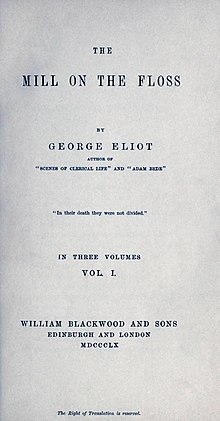The mill on the raft
The Mill on the Floss ( English title: The Mill on the Floss ) is a seven-part (book) novel by George Eliot ( pseudonym of Mary Ann Evans) from 1860 .
Summary of the plot
Dorlcote Mill on the Raft in central England near the seaside town of St. Ogg's (names and locations are fictional) has been owned by the respected Tulliver family for generations. Your current owner, Mr Tulliver, is an intelligent and kind-hearted, but easily tempered family man who, through reckless money lending and lawsuits and hatred of his opponent, the lawyer Wakem, has ruined his property, the family into poverty and himself into drives premature death.
His wife Bessie belongs to the narrow-minded, self-righteous, strict observance of convention and dominated by women Dodson clan.
The main character of the novel is her daughter Maggie Tulliver, who grows up with her brother Tom at the mill and the river. Tom is intellectually rather mediocre, feeble and domineering, but determined by unshakable moral principles. Maggie, on the other hand, is bright, sensitive, impulsive and in need of love, but she unconditionally submits to her older brother, whom she admires. She is always offensive to her aunts.
Tom receives private lessons from a pastor with Philip Wakem, the attorney's lively and artistically gifted but hunchback and shy son. Maggie and Philip become friends during a visit.
After their financial ruin, the Tullivers begin to suffer. The lawyer Wakem becomes the new owner of the mill, and Mr. Tulliver has to work as a tenant for the hated adversary. Tom struggles to repay the family's debt. Maggie, who has developed from an ugly duckling to an attractive young woman, forges a new relationship with Philip Wakem, who worships her almost like a goddess. Tom brutally forces his sister to end the relationship; she looks for a job abroad as a teacher.
When Maggie visits her friend and cousin Lucy Deane, she meets her quasi-fiancé, Stephen Guest. Stephen and Maggie are irresistibly drawn to each other, although Stephen wants to keep the engagement to Lucy and keeps Maggie by Philip. On a rather harmless boat trip, Maggie and Stephen compromise each other in the eyes of St. Ogg's society, from which Maggie is now ostracized. Only Lucy and Philip, whose hopes Maggie has destroyed, show understanding for her. Tom, now wealthy and owner of the mill again, shows her out of the house.
When the valley of the raft is ravaged by a great flood, Maggie first saves her brother in the boat, but then they both drown in the water, lying reconciled in each other's arms. "In their death they were not separated," says the common gravestone.
Editions and translations
- The Tauchnitz edition (at the same time as the first edition published in Great Britain): The Mill on the Floss , Bernhard Tauchnitz, Leipzig 1860
- in German: George Eliot, Eva-Maria König (translation, notes, epilogue): Die Mühle am Floss . In: Reclam's universal library RUB 8080 . Reclam, Stuttgart 1983, ISBN 3-15-002711-X (Original title: The mill on the Floss . Translated by Eva-Maria König).
Film adaptations of the novel
- USA 1915.
- England 1939 (Director: T. Whelen).
- La gran tentation, Argentina 1948 (directed by E. Arancibia).
- England 1997 (2006 BBC Worldwide, with Emily Watson)

